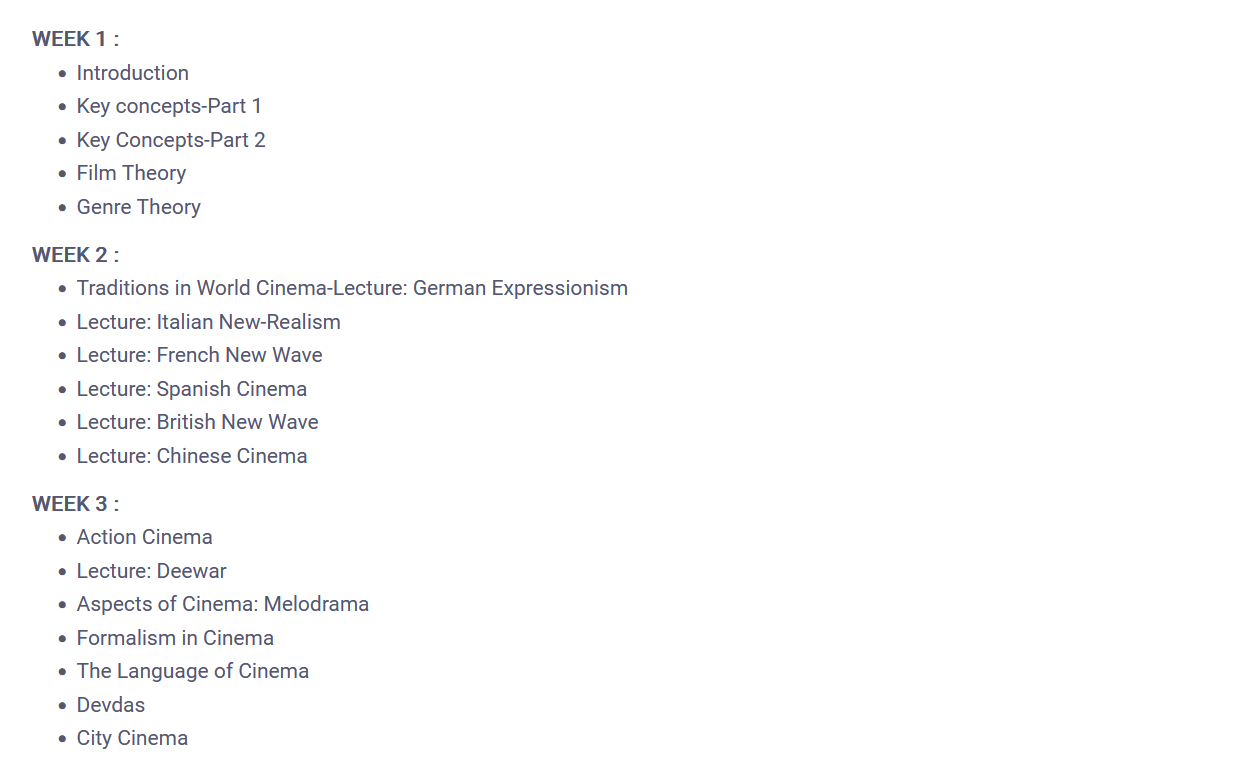The Film Appreciation syllabus in the USA offers a structured approach to understanding cinema’s artistic, cultural, and historical significance. It provides students with the tools to analyze films critically, covering a broad spectrum of genres, styles, and directors. The curriculum often includes the study of film theory, narrative structure, cinematography, editing, sound, and the socio-political impact of films. Through screenings, discussions, and written assignments, students engage deeply with both classic and contemporary films, developing an appreciation for film as an art form while also gaining insight into its role in shaping and reflecting society. Check full detailed Film Appreciation Syllabus here.
Film Appreciation Syllabus
The syllabus for a Film Appreciation course in U.S. universities typically varies by institution, but the structure generally focuses on developing a student’s understanding of film as an art form, cultural product, and technical achievement. Here’s a detailed breakdown of a typical Film Appreciation course syllabus:
Course Objectives:
- Develop an understanding of the basic elements of film (narrative, mise-en-scène, cinematography, editing, sound).
- Learn to critically analyze and interpret films in terms of form and content.
- Gain knowledge of the history of cinema, its major movements, and influential filmmakers.
- Understand the role of cinema in culture and society.
- Enhance appreciation for the artistic, social, and technical aspects of filmmaking.
Course Structure:
- Introduction to Film
- Definition and Scope of Film Appreciation
- Introduction to Basic Film Terminology
- Understanding the Film Production Process
- Overview of Film History and Development
- Film Form and Narrative
- The Concept of Narrative in Film
- Classical Hollywood Narrative Structure
- Nonlinear Narratives and Experimental Storytelling
- Plot vs. Story: Understanding Narrative Construction
- Mise-en-scène
- The Elements of Mise-en-scène (Setting, Costume, Lighting, Acting)
- Importance of Mise-en-scène in Shaping Meaning
- Analysis of Key Films for Mise-en-scène
- Cinematography
- Camera Angles, Shots, and Movements
- Cinematic Composition and Framing
- Lighting Techniques and Their Effects on Mood and Meaning
- Role of Color and Black-and-White Cinematography
- Editing
- Basic Principles of Film Editing (Continuity Editing, Montage)
- Types of Cuts and Transitions
- The Psychological and Emotional Impact of Editing
- Analysis of Edited Sequences in Classic and Modern Films
- Sound in Film
- The Role of Dialogue, Sound Effects, and Music in Film
- Diegetic vs. Non-Diegetic Sound
- The Impact of Sound on Narrative and Atmosphere
- Sound Design and Its Role in Enhancing Visuals
- Film Genres
- Exploration of Popular Film Genres (e.g., Horror, Comedy, Drama, Western, Noir)
- Analysis of Genre Conventions and Their Evolution
- The Relationship Between Genre and Audience Expectation
- Film History and Movements
- Early Cinema and Silent Films
- The Golden Age of Hollywood
- European and International Cinema (e.g., French New Wave, Italian Neorealism, Japanese Cinema)
- Modern and Postmodern Cinema
- Independent and Avant-garde Films
- Documentary and Non-Fiction Film
- Defining Documentary Film
- Types of Documentaries (Observational, Expository, Participatory)
- The Ethics of Documentary Filmmaking
- The Role of Documentaries in Society and Politics
- Global Cinema
- Exploration of World Cinemas (Asian, African, Latin American, European)
- Cross-cultural Film Narratives and Themes
- Globalization and Its Impact on Cinema
- Directors and Auteur Theory
- Understanding the Auteur Theory: Directors as Primary Creators
- Case Studies of Notable Directors (e.g., Alfred Hitchcock, Stanley Kubrick, Martin Scorsese, Agnes Varda)
- The Role of Director’s Vision in Film Interpretation
- Contemporary Film and Digital Media
- The Shift from Traditional to Digital Filmmaking
- The Impact of Digital Effects and CGI on Modern Cinema
- The Role of Streaming Platforms in Shaping Contemporary Film
- Cultural and Ideological Critique
- Representation of Gender, Race, and Class in Films
- Critical Theories in Film Studies (e.g., Feminism, Queer Theory, Postcolonial Theory)
- The Role of Cinema in Shaping Ideology and Identity
- Final Project / Film Review
- Students are typically required to complete a final project that may involve a film analysis, a research paper on a particular filmmaker or movement, or a creative short film project.
- Film reviews or critical essays that apply course concepts to a specific film or director.
Assessment:
- Quizzes and Exams: Covering film terminology, history, theory, and analysis.
- Film Screenings and Discussions: Weekly screenings of films followed by guided discussion or written reflections.
- Film Analysis Essays: In-depth analysis of selected films, focusing on technical and thematic aspects.
- Group Presentations: Presenting on topics such as film movements, directors, or specific genres.
- Final Paper/Project: A comprehensive research or creative project demonstrating mastery of course concepts.
Reading List (Sample Texts):
- Film Art: An Introduction by David Bordwell and Kristin Thompson
- A Short History of Film by Wheeler Winston Dixon and Gwendolyn Audrey Foster
- Understanding Movies by Louis Giannetti
- Selected articles from journals like Film Quarterly, Cineaste, or Sight & Sound.
Film Screenings:
Some universities require weekly screenings of films that are selected for their historical, technical, or cultural significance. These could range from early silent films like The Birth of a Nation to modern films like Parasite. The screenings often tie directly into the topics covered in lectures and readings.
Typical Films Studied:
- Citizen Kane (Orson Welles, 1941)
- Psycho (Alfred Hitchcock, 1960)
- La Jetée (Chris Marker, 1962)
- Do the Right Thing (Spike Lee, 1989)
- The Godfather (Francis Ford Coppola, 1972)
- Pulp Fiction (Quentin Tarantino, 1994)
- 2001: A Space Odyssey (Stanley Kubrick, 1968)
- Moonlight (Barry Jenkins, 2016)
This course syllabus may vary significantly depending on the professor’s specialization, the focus of the course, and whether it’s offered at an introductory or advanced level. Some courses might also include guest speakers, visits to film festivals, or practical components like short film production.
Film Apperication Syllabus USA University
Course Syllabus: DRAM 2366 Film Appreciation
Catalog Description Survey and analyze cinema including history, film techniques, production procedures, selected motion pictures, and cinema’s impact on and reflection of society.
Lecture hours = 3, Lab hours = 3
Prerequisites: N/A
Semester Credit Hours: 3
Lecture Hours per Week: 3
Lab Hours per Week: 3
Contact Hours per Semester: 96
State Approval Code: 50.0602.51 26
Class section meeting time:
Alternate Operations During Campus Closure: In the event of an emergency or announced campus closure due to a natural disaster or pandemic, it may be necessary for Panola College to move to altered operations. During this time, Panola College may opt to continue delivery of instruction through methods that include, but are not limited to: online learning management system (CANVAS), online
conferencing, email messaging, and/or an alternate schedule. It is the responsibility of the student to monitor Panola College’s website (www.panola.edu) for instructions about continuing courses remotely, CANVAS for each class for course-specific communication, and Panola College email for important general information.
Core Components and Related College Student Learning Outcomes
This course counts as part of the academic requirements of the Panola College Core Curriculum and an Associate of Arts or Associate of Science degree. Yes No: If no, skip to Instructional Goals. The items below marked with an X reflect the state-mandated outcomes for this course IF this is a CORE course: 2 Critical Thinking Skills – to include creative thinking, innovation, inquiry and analysis, evaluation
and syntheses of information
CT1: Generate and communicate ideas by combining, changing, or reapplying existing information
CT2: Gather and assess information relevant to a question
CT3: Analyze, evaluate, and synthesize information
Communication Skills – to include effective development, interpretation, and expression of ideas
through written, oral, and visual communication
CS1: Develop, interpret, and express ideas through written communication
CS2: Develop, interpret, and express ideas through oral communication
CS3: Develop, interpret, and express ideas through visual communication
Empirical and Quantitative Skills – to include the manipulation and analysis of numerical data or
observable facts resulting in informed conclusions
EQS1: Manipulate and analyze numerical data and arrive at an informed conclusion
EQS2: Manipulate and analyze observable facts and arrive at an informed conclusion
Teamwork – to include the ability to consider different points of view and to work effectively with
others to support a shared purpose or goal
TW1: Integrate different viewpoints as a member of a team
TW2: Work with others to support and accomplish a shared goal
Personal Responsibility – to include the ability to connect choices, actions, and consequences
to ethical decision-making
PR1: Evaluate choices and actions and relate consequences to decision-making
Social Responsibility – to include intercultural competence, knowledge of civic responsibility,
and the ability to engage effectively in regional, national, and global communities
SR1: Demonstrate intercultural competence
SR2: Identify civic responsibility
SR3: Engage in regional, national, and global communities
Instructional Goals and Purposes:
The purpose of this course is to examine the origins and growth of the motion picture from the beginnings
in the latter 19th century to the present day. Focus includes film history and key developments in film
technology; dramatic aspects of the narrative film; cinematography, film aesthetics, genres, and auteur
study; sociological ramifications of film; and the general growth of the business of the motion pictures
industry. Supervised film viewing sessions are required. Course provides an emphasis on the analysis of
the visual and aural aspects of selected motion pictures, historical growth and sociological effect of film
as an art. This course empowers students to explore realities, relationships, and ideas of world culture
through the study of cinema. Students analyze the basic elements of cinematic form as seen through
essential properties of the medium including editing, cinematography, production design, and sound
design and gain an appreciation of film history and for the impact of culture and technology on the
development of the cinema.
Learning Outcomes: [from the ACGM catalog]
After studying all materials and resources presented in the course, the student will be able to:
1. Analyze film through written response.
2. Demonstrate a basic knowledge of film history, form, and genre.
3. Describe the collaborative nature of cinema and the many jobs required to develop a motion
picture.
4. Discuss/Describe the relationship of cinema to society as it relates to his/her perspective.
Course Content:
A general description of lecture/discussion topics included in this course are listed in the Learning
Objectives section of this syllabus.
Students in all sections of this course will learn the following content:
1. Film as Art: Creativity, Technology, and Business
2. The Significance of Film and Narrative Form
3. Film Styles
4. Film Genres
5. Critical Analysis of Film
6. Film History
7. Cultural, Social, and Global Impact of Film.
Methods of Instruction/Course Format/Delivery:
This course is offered in the following formats: lecture, online discussions, online Canvas Content, and
supervised film viewing. Face-to-face contact in class as well as online contact delivered through
Canvas.
Major Assignments / Assessments:
The following items will be assigned and assessed during the semester and used to calculate the
student’s final grade.
Assignments
1. Reading assigned chapter materials, provided reading material, website content. and
completing assigned quizzes over provided material.
2. Participating in class discussion in face-to-face format and/or Discussion Topics for online
students.
3. Viewing all assigned films.
4. Submitting written assignments via Canvas as assigned.
5. Various research projects over content.
Assessment(s):
1. Exams
2. Tests
3. Quizzes
4. Discussion Assignments
5. Project Assignments

